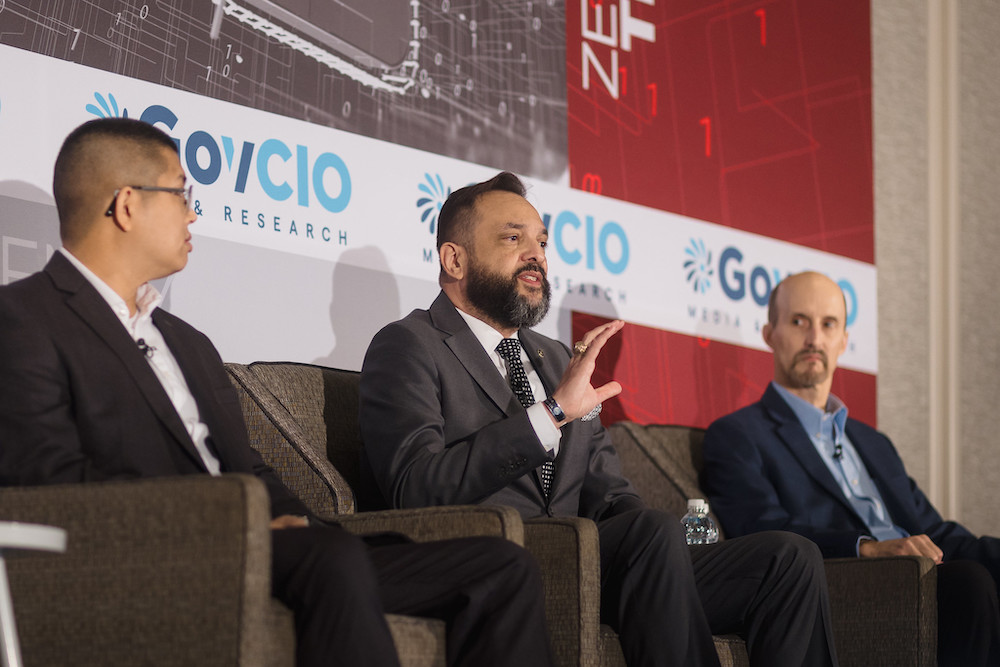DOD Adapting Cloud Strategy to Meet Pace of Technical Change
The Pentagon’s cloud office lead discusses the shift away from the JEDI cloud contract and what this means for its data modernization goals.

The Defense Department is updating its cloud-computing strategy and IT acquisitions to better meet the pace of technological change.
The agency’s recent cancellation of its heavily disputed JEDI cloud contract has highlighted what the path forward will be DOD’s next phase of cloud modernization. The agency is moving toward a more flexible contracting model that will more feasibly enable technology modernization. This also encompasses a more open approach to acquisitions that will create a more competitive field for firms that might offer the best solutions from an evolving marketplace.
In remarks to GovernmentCIO Media & Research, Sharon Woods, executive director of DOD’s Cloud Computing Program Office, discussed the ultimate goals of the Pentagon’s cloud modernization program and its shifting approach to technology acquisitions.
The DOD’s cloud migration program is a comparatively recent endeavor, one that began four years prior as part of a broader push to facilitate new tech adoption across the U.S. Armed Forces as a whole.
“The conversation around large-scale cloud migration changed in 2017 when the Department announced the effort to accelerate cloud adoption. The initiative to accelerate cloud adoption was a recognition that cloud was not just for business systems, but also warfighting requirements,” Woods said.
This cloud migration was initiated with specific organizational goals in mind, particularly as the backbone for supporting more data and computationally intensive programs across DOD.
“The move to a commercial cloud solution is a pillar of the Department’s drive to digital and software modernization. It’s not so much about the cloud, but what the cloud enables you to do. Enterprise commercial cloud is a springboard for critical initiatives like [Joint All-Domain Command, Control Framework (JADC2)] and [Artificial Intelligence and Data Acceleration (ADA)],” Woods said.
However, the foundational importance of cloud-based storage models in supporting cutting edge capacities across DOD has led to the Pentagon reevaluating its approach since planning began in earnest four years prior. This has encompassed a reevaluation of cloud contracting and associated technology acquisitions in the wake of moving away from the single-award JEDI contract.
“Over the last few years, the cloud computing industry has undergone significant technical advancements and marketplace changes that make it feasible for the Department to enter into a multi-vendor contract. These advances have resulted in expanded marketplace maturity, particularly with regard to multi-cloud and distributed-cloud deployment strategies. In addition, the DOD’s experience with utilizing cloud services and the lessons learned from the multi-cloud projects underway has increased the Department’s cloud conservancy,” Woods said.
This approach is embodied within the newly announced Joint Warfighting Cloud Capability (JWCC), a multi-vendor contract designed to open the competitive space rather than attach the DOD to one fixed provider.
“The Joint Warfighting Cloud Capability (JWCC) initiative is important in keeping pace with rapid technological change. The contract terms will ensure that DOD is continually receiving the best tech solutions that the commercial cloud marketplace has to offer — at all three classification levels with tactical edge capabilities,” Woods said.
The ultimate goal of this shift has been to maintain America’s strategic edge while more quickly and effectively putting new technology into the hands of the warfighter.
“Cloud infrastructure and platform services provide the foundation that allows mission owners to process information and make decisions faster than our adversaries can. Efforts like DevSecOps let us more quickly develop applications and capitalize on our data. Other efforts like [ADA] enable us to implement data standards and achieve a level of data analysis that is only possible with cloud algorithms. The multi-classification and tactical edge capabilities that JWCC will deliver further extend and scale all of these initiatives to where the military operates,” Woods said.
This is a carousel with manually rotating slides. Use Next and Previous buttons to navigate or jump to a slide with the slide dots
-

CISA, DOD Tackle Next Steps in Zero-Trust Implementation
Federal leaders discuss future strategies and culture impacts around successful zero trust implementation amid new organizational structures.
3m read -

'Balance' Needed in Hybrid Cloud Security, Interoperability
Federal officials from CISA and SOCOM say hybrid cloud cybersecurity needs a holistic approach to be successful.
4m read -

DOD Deputy CIO's Tech, Cyber Priorities for 2024
Leslie Beavers outlines how her office is enabling innovation for key efforts including zero trust, 5G connectivity, cloud and more.
3m read -

DISA HaC Looks to be the 'Warfighter's Cloud Provider of Choice'
DISA's Korie Seville said balancing needs and training are critical to the cloud mission across the Defense Department.
3m read




